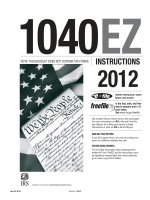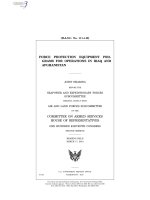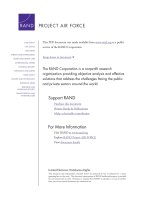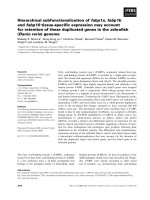FINANCIAL AUDIT Air Force Does Not Effectively Account for Billions of Dollars of Resources_part2 doc
Bạn đang xem bản rút gọn của tài liệu. Xem và tải ngay bản đầy đủ của tài liệu tại đây (1009.45 KB, 12 trang )
Page 13
GAO/AFMD-90-23 Air Force Financial Audit
This is trial version
www.adultpdf.com
\ Chadter 1
Inkroduction
Throughout the 1980s concern has mounted over the federal govern-
ment’s declining fiscal condition and the ineffective ways in which it
manages and controls its financial operations. From the beginning of the
1980s to the present, the government has faced the problem of a federal
debt which has grown from about $900 billion to almost $3 trillion and
which has incurred related interest costs (now about $241 billion, or 27
percent of the general expenses of the government). In addition, the gov-
ernment has become saddled with hundreds of billions of dollars in
unanticipated liabilities which are not even included in the cash-basis
debt figures cited above, but for which the government must ultimately
bear the cost. On top of these liabilities are unmet national needs which
will also require funding in future years and further add to the deficit.
These conditions were not sudden; the events causing them occurred
over many years. Yet, the problems and their severity were not fully
recognized. In most cases, the government was not tracking the costs of
its obligations and needs as they were being incurred; in other cases,
information was available to indicate the need for timely action, but this
information was not taken into account in decisionmaking. It is time for
these problems to be identified and dealt with.
The Government’s
In today’s complex economic, political, and social environment, compet-
Financial Information
ing demands to fund government programs and activities require accu-
rate and timely financial information for making sound resource
and Control
allocation decisions, The government also needs to have proper financial
Environment
control over its costs and assets to ensure that it is operating govern-
ment programs in a cost-effective manner.
With distressing frequency, however, there are dramatic revelations in
the media and elsewhere of financial improprieties by government offi-
cials or extremely wasteful practices by federal agencies. The reason
these situations were allowed to occur-their root cause-is basically
the absence of good internal controls and accounting systems. However,
this fact is often overshadowed by the drama of the events themselves.
The recent scandal at the Department of Housing and Urban Develop-
ment (HUD) is a good example where the lack of good financial controls
has seriously impacted several of the nation’s housing programs and the
integrity of government.
HUD,
however, is not alone. The Director of the
Office of Management and Budget
(OMB)
recently testified before the
Senate Committee on Governmental Affairs that “The recently-exposed
HUD
problems are not unique, not merely peculiar to a particular agency
Page 14
GAO/AFMD-90-23 Air Force Financial Audit
This is trial version
www.adultpdf.com
Chapter 1
Introduction
under what some have described as absentee management There are
analogous problems in other agencies.”
Those involved in such scandals are investigated and sometimes prose-
cuted, but the poorly controlled, antiquated, and ineffective financial
environments which permitted the events to occur in the first place too
often remain the same. Moreover, such environments also contribute to
waste and inefficient use of resources, uninformed decisionmaking, and
diminished public confidence in the government. Ultimately, these fac-
tors may be far more costly than the losses through fraudulent activities
that surface from time to time.
Our evaluation of federal financial practices clearly shows that the gov-
ernment does not adequately control its resources; provide its managers,
the Congress, or the public with a true accounting for the financial
assets entrusted to it; or effectively use financial information to make
decisions. In a 1986 special report, Managing the Cost of Government
(GAO~AFMD-8536~),
we described six pervasive problems in the manner in
which the federal government manages its financial resources and costs.
These problems are
. poor quality of financial management information;
l
poor linkages between the budgeting, budget execution, and accounting
phases of the financial management process;
. inadequate attention paid to monitoring and comparing budgeted activ-
ity with actual results;
l
primary emphasis on fund control, leading to inadequate attention in
other areas of federal financial management;
. inadequate disclosure of assets, costs, and liabilities; and
. antiquated and fragmented financial management systems.
In a November 1989 report,’ we cited a number of problems which are
illustrative of the situation governmentwide. For example, the federal
government continues to rely on antiquated accounting systems that,
despite improvement efforts over many years, have serious problems. In
other cases, federal agencies are spending billions of dollars developing
and acquiring automated systems but are experiencing massive
problems in the process, This report also cited the increase of spare
parts inventories at the Department of Defense
(DOD)
and concluded
that, while much of this growth resulted from increased costs due to
‘Financial Integrity Act: Inadequate Controls Result in Ineffective Federal Programs and Billions in
Losses(GAO/AF'MD90 10
_ -
, November Z&1989).
Page I5
GAO/AFMD-90-23 Air Force Financial Audit
This is trial version
www.adultpdf.com
Chapter 1
Introduction
inflation and support for weapons systems modernization, a sizable por-
tion represented unneeded inventories, The amount of unneeded secon-
dary items increased from approximately $10 billion in 1980 to about
$29 billion 1988.
1
Meaningful Financial
In response to mounting concerns of the public, the Congress, the media,
and executive branch officials over the federal government’s fiscal con-
Statements and Audits d’t’
1 ion, a number of federal agencies have undertaken major initiatives
Can Strengthen
to improve and modernize their financial practices, systems, and con-
Federal Financial
trols. This represents a mammoth and difficult task, given the years of
Mabagement
neglect and low priority given to financial management, the size and
complexity of federal operations, and the magnitude of taxpayers’ dol-
lars involved. Yet, these are the very factors which make it so critical
that these operations be placed under sound financial control.
Decisionmakers who direct federal programs, like their counterparts in
private industry, need to know the cost of prior decisions in arriving at
the most economical solution to present problems. Air Force and
DOD
management, the Department of the Treasury, the Office of Manage-
ment and Budget, and the Congress also need to regularly review the
results of operations and the financial position of the federal agencies
they oversee. The data for such accountability reporting should flow
from financial management systems that can accurately capture, pro-
cess, and report day-to-day transactions involving billions of dollars.
The integrity of these data, the systems that process them, and the
resultant internal and external reports can only be relied upon when
they are produced by the kind of disciplined process that results from
annual independent audits.
As part of the reform effort for better financial management, several
federal agencies have attempted to develop meaningful financial state-
ments, along with underlying records and documentation adequate to
permit an independent auditor to express an opinion on the statements.
The process of generating and accumulating financial information neces-
sary to prepare accurate and meaningful statements instills discipline in
the system and strengthens accountability. This discipline is further
enhanced when the statements and the underlying information are sub-
jected to the rigors of an audit. Financial statement audits ensure that
accounting transactions, accounting systems, financial statements, and
financial reporting to the Congress, Treasury, the Office of Management
and Budget, and the public are properly linked and consistent. Such
audits also provide the opportunity for an independent evaluation of the
Page 16
GAO/APMD-90-23 Air Force Financial Audit
This is trial version
www.adultpdf.com
Chapter 1
Introduction
adequacy and effectiveness of the controls and safeguards for protect-
ing the resources entrusted to an agency and for ensuring that the
agency fully and fairly discloses its financial condition and operations.
The importance of financial statements and independent audits has long
been recognized by the private sector and, more recently, in the public
sector on the state and local levels. Audited annual financial statements
of federal entities, prepared according to generally accounting accepted
principles and standards,2 are urgently needed to provide useful, reliable
information to the Congress, federal managers, and the public in a
readily understood format.
Over the past several years, our financial audit work at both the civilian
and defense agencies shows similar patterns of shortcomings. Essen-
tially, these involve weaknesses in the basic controls over the accuracy
of financial data, and the fact that all financial information needed for
effective management, accountability, and oversight is not produced
and utilized. It is noteworthy that the majority of these entities have
received qualified or adverse opinions on their financial statements
because of financial weaknesses. We have noted that, typically,
improvements are made after initial audits, but many of these entities
must make substantial long-term improvements in correcting weak-
nesses in internal controls and need to develop sound, integrated
accounting systems capable of producing complete, accurate financial
information.
Having good financial information is particularly important in the
Department of Defense, which, in this era of budget constraints and
changing world conditions, will likely have to live with no-growth, or
even declining, budgets in the foreseeable future.
DOD’S
&year defense
plan contained programs which reportedly would cost about $150 billion
more than
DOD
can expect to receive during the period. This will force
difficult choices of which programs to terminate or curtail and how best
to finance those that are to be continued.
DOD
must not only adjust its
proposed programs and spending patterns to recognize current fiscal
realities, but it must also achieve greater efficiency and more effective
management of future appropriations and the resources it already has
on hand. To effectively do so,
DOD
must have complete and accurate data
on its costs and resources. These data can only be produced by a fully
“These arc contained in Title 2 (“Accounting Principles and Standards for Federal Agencies”) of
GAO’s Policy and Procedures Manual for Guidance of Federal Agencies.
Page 17
GAO/AFMD-90-23 Air Force Financial Audit
This is trial version
www.adultpdf.com
Chapter 1
Introduction
functional and complete accounting system disciplined by independent
audits.
To begin to gain a perspective on the quality of the financial information
and systems available in
DOD,
we attempted to conduct a financial audit
of the Air Force. The Air Force is the only military service which has
attempted to prepare a set of financial statements in accordance with
generally accepted accounting principles for federal agencies. A copy of
the Air Force’s financial statements, upon which we did not express an
opinion, is contained in appendix I. We concluded that the Air Force
statements were unauditable.
DGpartment of the Air
The Department of the Air Force, created in 1947, is responsible for pre-
Fo)-ce
paring aerospace forces to perform offensive and defensive operations
with the purpose of defending the United States, deterring aggression,
and being ready to conduct warfare in conjunction with the other armed
forces. To fulfill this mission, the Air Force has resources valued at
about $275 billion and receives almost $90 billion in annual appropria-
tions. The Air Force operates over 130 bases located throughout the
world, representing about 16 percent of the real property held by the
U.S. government. In addition to these facilities, the Air Force manages a
reported $99.1 billion of weapons systems (aircraft, missiles, and
engines) and a reported $63.8 billion of inventories of supplies and
spare parts, which amounts to about 20 percent of the equipment and
almost 30 percent of the inventories held by the U.S. government. The
Air Force employs about 900,000 civilian and military personnel.
Objectives, Scope, and
Our review objectives were to (1) work with the Air Force to develop its
Methodology
first set of consolidated financial statements and establish a baseline for
a full audit of the 1989 financial statements, (2) audit the account bal-
ances contained in the financial statements, (3) identify problems in the
Air Force’s financial management and accounting systems, and test the
effectiveness of significant internal control procedures, and (4) identify
opportunities for the Air Force to improve its financial management
operations. In pursuing these objectives, we reviewed the accounts com-
prising the Air Force’s 1988 financial statements and reviewed the Air
Force’s financial management operations, including key internal controls
which relate to recording, processing, summarizing, and reporting finan-
cial data. This report covers significant internal control, accounting, and
financial management issues as well as problems with respect to certain
individual accounts.
Page 18
GAO/AFMD-90-23 Air Force Finaucial Audit
This is trial version
www.adultpdf.com
Chapter 1
Introduction
This review included coverage of the Air Force’s financial management
operations and accountability for the primary resources-personnel,
facilities, inventory, and equipment-it uses to accomplish its mission.
We reviewed the Air Force’s policies relating to its organization,
accountability procedures, and financial management. We also consid-
ered previous reports by
GAO,
Air Force Audit Agency, Defense Audit
Service, and Air Force pursuant to the Federal Managers’ Financial
Integrity Act of 1982. We discussed financial management operations
and accountability procedures, functions, and processes with managers
throughout the Air Force. We identified internal controls in the account-
ing systems and operations for the primary resources. Our audit tests
focused on the key internal controls specifically related to financial
management and accountability for resources,
Finahcial Management
The Air Force Accounting and Finance Center is the focal point for Air
Force financial operations for the worldwide network of over 120 Air
Force Accounting and Finance Offices and numerous disbursing agent
offices. The center is responsible for accounting for all money appropri-
ated to the Air Force and for reports to the Congress and financial man-
agers throughout the government on the use of these funds.
The Air Force’s financial operations are under the overall direction of
the Assistant Secretary for Financial Management who functions as the
Air Force’s chief financial officer. The Air Force’s financial management
structure is decentralized. The Air Force Comptroller is primarily
responsible for systems that account for, control, and report on appro-
priated funds and cash. Separate logistics and other systems support the
Comptroller’s general ledger accounting systems. We worked with the
Air Force to develop an inventory of its financial management systems.
Weapons Systems
Management
The Air Force Systems Command develops and purchases weapons sys-
tems (aircraft, missiles, and uninstalled engines). About $25 billion of
the Air Force’s fiscal year 1988 budget was designated for weapons sys-
tems acquisition. The-Air Force had thousands of outstanding contracts
valued at over $250 billion as of September 30, 1988. Accountability for
these systems begins during production and extends through their use at
air bases.
Inventory Management
The Air Force manages inventories of over 1.6 million different spare
parts and supplies valued at over $60 billion. About $40 billion of the
Page 19
GAO/AFMD-90-23 Air Force Financial Audit
This is trial version
www.adultpdf.com
-7
Chapter 1
Introduction
inventory is maintained at air logistics centers and about $20 billion at
air bases, Managing the inventory includes not only maintaining physi-
cal control and distribution, but also contracting to acquire the items
and then using the inventory to maintain operations. Depot maintenance
industrial fund activities are collocated with air logistics centers and use
their inventories to maintain and repair weapons systems.
We conducted our review between July 1987 and January 1990, using
data related to fiscal year 1988. Our review was performed in accor-
dance with generally accepted government auditing standards. Work
was performed at Air Force headquarters in Washington, D.C., and loca-
tions worldwide.
Chapter 2 discusses financial management systems and procedures in
the Air Force, while chapter 3 contains a discussion of weaknesses in
basic internal controls which prevent accurate financial reporting and
reduce accountability over assets. Chapter 4 identifies problems the Air
Force faces in determining the actual costs of military hardware. Con-
cerns about the quantities and valuation of Air Force inventories are
contained in chapter 5. Chapter 6 discusses Air Force efforts to improve
its financial management systems. The Air Force’s consolidated finan-
cial statements are included as appendix I, a comparison of the consoli-
dated financial statements with Treasury reports as appendix II, and
our scope and methodology as appendix III. Comments from the Depart-
ment of Defense are included as appendix IV.
Page 20 GAO/APMD-99-23 Air Force Financial Audit
This is trial version
www.adultpdf.com
Chanter 2
l?i$wial Management Systems Do Not Provide
Reliable Financial Information
I
The magnitude of assets and funds for which the Air Force is responsi-
ble is matched by only a handful of other organizations worldwide. The
Air Force is recognized as a world leader in developing and operating
weapons systems on the cutting edge of technology to provide security
for the United States and its allies. In contrast, the Air Force financial
systems and practices for controlling and managing its immense array of
assets and vitally important and complex operations are unquestionably
obsolete and incapable of providing the kinds of reliable financial infor-
mation every organization needs for effective and efficient management.
The poor state of the Air Force’s financial management is clearly indi-
cated by the fact that it was not able to produce a set of credible finan-
cial statements, something most business entities and many state and
local governments do routinely and regularly.
The accounting and financial management systems generally do empha-
size fund control requirements, that is, making sure spending limits are
not exceeded. With some exceptions, we noted that fund control is ade-
quate; expenditures did not exceed appropriations. However, the sys-
tems do not effectively account for and control the actual costs incurred.
The Air Force operates a total of 131 different accounting and financial
management systems, many of which are not linked under an integrated
general ledger. Moreover, some assets, including the Air Force’s major
weapons systems-reportedly valued at $99.1 billion-are not under
the control of any accounting system. In short, the Air Force does not
provide basic double-entry accounting control over significant portions
of its financial operations.
The existing financial systems do produce data which could be used to
help plan for, manage, and control resources. All too often, however,
such data are not considered in the normal course of operations nor used
to perform analytical techniques which would disclose operating
problems, Similarly, when the financial systems produce information
which is obviously wrong or merits investigation, these problems are
often ignored
This results in unreliable financial reporting both internally and exter-
nally. The processes which could not produce acceptable financial state-
ments are the same processes providing information to Air Force
management at all levels and to outside organizations such as Treasury
and the Congress.
Page 21
GAO/AFMD-90-23 Air Force Financial Audit
This is trial version
www.adultpdf.com
Chapter 2
Financial Management Syeteme Do Not
Provide Reliable Financial Information
-
Need for Meaningful,
Akurate Financial
and operations of an entity that cannot be obtained elsewhere. Produc-
ing the financial statements requires a discipline throughout the organi-
Stptements
zation to properly account for the resources entrusted to managers to
perform their mission. The financial information produced by this pro-
cess can be used by managers to assess the varying, complex operations
in an agency and to monitor the performance of subordinates against
expectations through the costs and budgeted funds.
The Air Force’s efforts to produce consolidated financial statements for
fiscal year 1988 represent a substantial commitment to improving its
overall financial management. However, these efforts were hindered by
the fact that much of the information needed to produce the statements
was not maintained on a systematic, consistent basis under basic double-
entry accounting control. The Air Force does not have an integrated gen-
eral ledger system from which statements can be produced. Also, the
information it does record is not as useful as it could be because the Air
Force does not follow generally accepted accounting principles in valu-
ing its equipment and it does not record depreciation for all of its depre-
ciable assets.
Air Force Lacks an
Integrated General Ledger
The Comptroller General’s accounting principles and standards (Title 2)
state that an agency’s accounting system must be an integral part of its
total financial management structure and must (1) provide sufficient
discipline and effective internal control over operations to protect
appropriated funds, cash, and other resources from fraud, waste, and
mismanagement, and (2) produce reliable and useful financial informa-
tion on the results of operations to support decisionmaking. Accord-
ingly, a general ledger serves as an integral part of an agency’s financial
management system and as an essential control mechanism by summa-
rizing all of an activity’s financial data for top management and
decisionmakers.
The Air Force, however, lacks a double-entry general ledger system to
provide a consolidated source of such financial information. To account
for its resources, the Air Force operates a large number of financial
management systems. Working with the Air Force, we identified 131
systems which it uses: 84 are classified as accounting systems and 47
are systems that feed data to these accounting systems. Taken together,
these systems are supposed to (1) account for, control, and report on the
Page 22 GAO/AFMD-90-23 Air Force Fhncial Audit
This is trial version
www.adultpdf.com
Chapter 2
Finandal Management Systems Do Not
Provide Reliable Financial Information
status of the Air Force’s appropriated funds and cash, (2) maintain sup-
porting records and other resources, and (3) accumulate the cost of deci-
sions and actions in carrying out the Air Force’s mission and operations.
The Air Force’s 47 subsidiary systems were established primarily to
support the Air Force’s various program and administrative missions
and goals, such as major weapons systems, procurement, and inventory
management. These systems also serve as a starting point to authorize
and initially record detailed information on the financial effects of its
mission operations eventually recorded in the accounting systems.
The Air Force’s 1988 annual report prepared pursuant to the Federal
Managers’ Financial Integrity Act of 1982
(FMFIA)
contained the Air
Force’s annual assessment of its accounting systems’ compliance with
accounting principles, standards, and related requirements for federal
agencies. The Air Force reported that two of its primary accounting sys-
tems, the General Accounting and Finance System
(GAFS)
and the
Defense Integrated Financial System, did not substantially conform with
the required accounting principles and standards.
The Air Force attempts to use
GAFS
to fulfill the functions of a general
ledger system. It was designed to record, process, summarize, and report
the financial results for the various Air Force activities. However,
according to Air Force officials,
GAFS
was not implemented in a manner
permitting it to satisfactorily perform these functions. As a result,
neither
GAFS
nor the underlying financial systems provide all the data on
accounts needed to prepare financial statements or other financial
reports.
Information Needed for
A general ledger system should serve as the basis for preparing financial
Financial Statements Not
statements and other financial reports. However, the Air Force’s finan-
Produced From
cial statements did not flow from and are not supported by either a gen-
Accounting Systems
eral ledger system or subsidiary accounting systems. The Air Force used
alternative sources to obtain the necessary data for its financial state-
ments In some instances, the data for the financial statements were
developed from budgetary subsystems within
GAB.
While the budgetary
subsystems operated within the financial management structure, the
accounting data were not routinely processed into the general ledger
accounts and had to be developed based on extract programs written
specifically to pull together financial data from budgetary reports for
Page 23
GAO/APMDBO-23 Air Force Financial Audit
This is trial version
www.adultpdf.com







![Financial Audit Manual [This page intentionally left blank.] ppt](https://media.store123doc.com/images/document/14/rc/rq/medium_QwDzJhAwHp.jpg)

